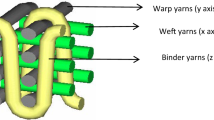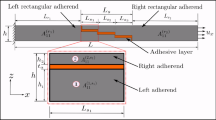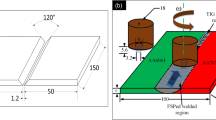Abstract
In this paper, numerical model of thick adhesive inclined joints has been prepared and validated against experimental test to study the effect of manufacturing defect on the joint strength. The inclined joint was made up of two laminate webs attached to a wedge by a layer of adhesive. Tensile tests were conducted on many thick adhesive joint specimens with two different geometries. One half of the symmetric test specimen was then modeled using finite element analysis in which cohesive zone modeling (CZM) was used to simulate the initiation and propagation of joint fracture. The progressive fracture through the adhesive layer and along adhesive-laminate interface was carefully examined. Based on inspection of the experimental test specimen, potential manufacturing defect types and locations were incorporated in the finite element model. The reduction in strength due to these manufacturing defects was used to predict the most critical flaw type in thick inclined joints. The differences between the “flawless” numerical model and the experimental test specimen was explained when these manufacturing defects were incorporated. The results were found to be consistent with the experimental tests.
Similar content being viewed by others
References
A. J. Kinloch, Adhesion and adhesives: Science and technology, Chapman and Hall (1987).
R. D. Adams and P. Cawley, A review of defect types and nondestructive testing techniques for composites and bonded joints, NDT Int., 21 (4) (1988) 208–222.
X. He, A review of finite element analysis of adhesively bonded joints, Int. J. Adhes. Adhes., 31 (2011) 248–264.
L. J. Hart-Smith, Further developments in the design and analysis of adhesive-bonded structural joints, Join. Compos. Mater., ASTM International (1981) 3–3-29.
N. Stein, P. Weißgraeber and W. Becker, A model for brittle failure in adhesive lap joints of arbitrary joint configuration, Compos. Struct., 133 (2015) 707–718.
F. Hélénon et al., Investigation into failure of laminated composite T-piece specimens under bending loading, Compos. Part A Appl. Sci. Manuf., 54 (7) (2013) 182–189.
M. Elhannani et al., Numerical analysis of the effect of the presence, number and shape of bonding defect on the shear stresses distribution in an adhesive layer for the single-lap bonded joint; Part 1, Aerosp. Sci. Technol., 62 (2017) 122–135.
M. Elhannani et al., Influence of the presence of defects on the adhesive layer for the single-lap bonded joint—Part II: Probabilistic assessment of the critical state, Aerosp. Sci. Technol., 63 (2017) 372–386.
H. Schonhorn, F. W. Ryan and T. T. Wang, Effects of symmetrical bonding defects on tensile shear strength of lap joints having ductile adhesives, J. Appl. Polym. Sci., 15 (5)(1971) 1069–1078.
N. G. Berry and J. R. M. D’Almeida, The influence of circular centered defects on the performance of carbonepoxy single lap joints, Polym. Test., 21 (2002) 373–379.
W. Xu and Y. Wei, Strength analysis of metallic bonded joints containing defects, Comput. Mater. Sci., 53 (2012) 444–450.
M. Shishesaz and N. Bavi, Shear stress distribution in adhesive layers of a double-lap joint with void or bond separation, J. Adhes. Sci. Technol., 27 (11) (2013) 1197–1225.
Y. Hua, A. R. M. Kasavajhala and L. Gu, Elastic-plastic analysis and strength evaluation of adhesive joints in wind turbine blades, Compos. Part B Eng., 44 (1) (2013) 650–656.
Y. M. Ji and K. S. Han, Fracture mechanics approach for failure of adhesive joints in wind turbine blades, Renew. Energy, 65 (2014) 23–28.
J. F. Mandell et al., Analysis of SNL/MSU/DOE fatigue database trends for wind turbine blade materials, Albuquerque, NM, and Livermore, CA (2010).
R. Krueger, Virtual crack closure technique: History, approach, and applications, Appl. Mech. Rev., 57 (2) (2004) 109.
C. S. Ban et al., Strength prediction of adhesive joints using the modified damage zone theory, Compos. Struct., 86 (1–3) (2008) 96–100.
N. Moës and T. Belytschko, Extended finite element method for cohesive crack growth, Eng. Fract. Mech., 69 (7) (2002) 813–833.
A. Turon et al., An engineering solution for mesh size effects in the simulation of delamination using cohesive zone models, Eng. Fract. Mech., 74 (10) (2007) 1665–1682.
A. Hillerborg, M. Modéer and P.-E. Petersson, Analysis of crack formation and crack growth in concrete by means of fracture mechanics and finite elements, Cem. Concr. Res., 6 (1976) 773–782.
D. S. Dugdale, Yielding of steel sheets containing slits, J. Mech. Phys. Solids, 8 (2) (1960) 100–104.
G. I. Barenblatt, The mathematical theory of equilibrium cracks in brittle fracture, Adv. Appl. Mech., 7 (1962) 55–129.
K. Ha, H. Baek and K. Park, Convergence of fracture process zone size in cohesive zone modeling, Appl. Math. Model., 39 (19) (2015) 5828–5836.
N. Blal et al., Artificial compliance inherent to the intrinsic cohesive zone models: Criteria and application to planar meshes, Int. J. Fract., 178 (1–2) (2012) 71–83.
M. L. Falk, A. Needleman and J. R. Rice, A critical evaluation of cohesive zone models of dynamic fracture, Jounal Phys. IV, Proc., 122 (June) (2001) 43–50.
G. R. Irwin, Plastic zone near a crack and fracture toughness, Proc. Seventh Sagamore Ordnance Mater. Conf. Vol IV, New York: Syracuse University (1960) 63–78.
M. L. Benzeggagh and M. Kenane, Measurement of mixedmode delamination fracture toughness of unidirectional glass/epoxy composites with mixed-mode bending apparatus, Compos. Sci. Technol., 56 (4) (1996) 439–449.
Author information
Authors and Affiliations
Corresponding author
Additional information
Recommended by Associate Editor Heung Soo Kim
Tsinuel Nurilligne Geleta received his B.Sc. in Civil Engineering from Adama Science and Technology University, Ethiopia (2013) and M.Sc. in Computational Structural Engineering from Chungbuk National University, Korea (2017). He is currently a Ph.D. student of wind engineering at Western University, Canada. His research interest areas are progressive damage of structures, dynamic loads on structures, fluid-structure interactions, computational mechanics (FEA and CFD).
Kyeongsik Woo is Professor at Chungbuk National University, Korea. He received his B.S. and M.S. degrees in aerospace engineering from Seoul National University, Korea and his Ph.D. in aerospace engineering from Texas A&M University, USA. His current research interests include textile composites, fracture simulation using CDM and CZM methods, high velocity impact behavior of composite materials, and fluid-structure interaction problems.
Douglas S. Cairns is the Lylse A. Wood Distinguished Professor at Montana State University. He has over 39 years’ experience in the design, analysis, manufacturing, and testing of composite materials and structures. He has Ph.D. MIT Aeronautics and Astronautics, scale, M.S. M.E. and BSME University of Wyoming.
Daniel D. Samborsky received his B.S. degree in Mechanical Engineering (1992) and M.S. degree in Civil Engineering (2000) from Montana State University. Currently he is a Composite Material Research Engineer at Montana State University.
Rights and permissions
About this article
Cite this article
Geleta, T.N., Woo, K., Cairns, D.S. et al. Failure behavior of inclined thick adhesive joints with manufacturing defect. J Mech Sci Technol 32, 2173–2182 (2018). https://doi.org/10.1007/s12206-018-0426-z
Received:
Revised:
Accepted:
Published:
Issue Date:
DOI: https://doi.org/10.1007/s12206-018-0426-z




